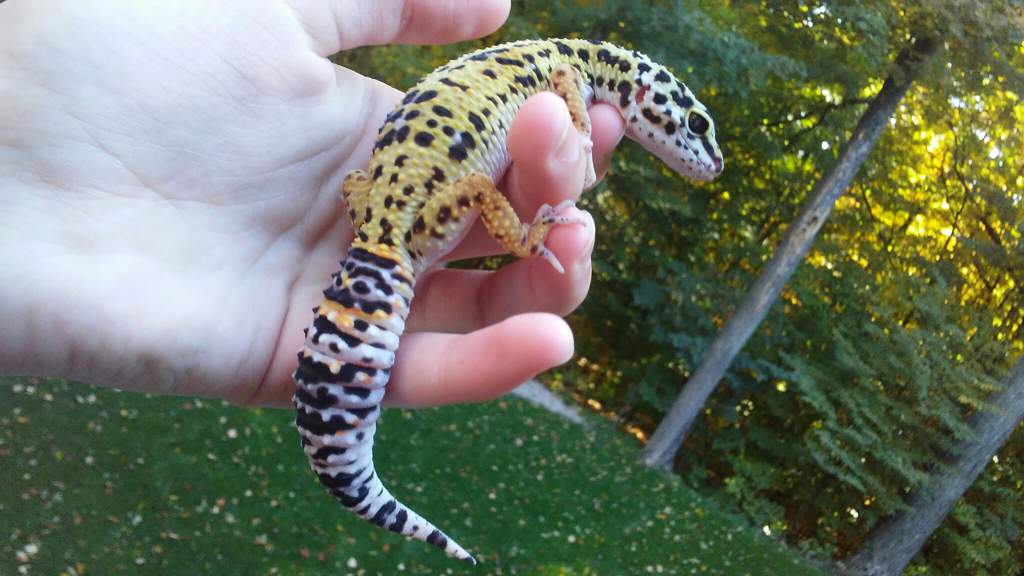- oof hello. i own a leopard gecko named Tango!! hes really rude. im pretty sure hes a high yellow carrot tail.

also just gonna say the FAQ on the front is so... misinforming. it sounds a lot like the information petsmart and petco give you, which is mostly wrong. ive sent a pm to Crum but it seems they havent been on in a while... so ill just put my updated version here. vv
- -
Are they easy to care for?
Yes! They are not much work. They even do not stink, only their poop does. They don't make much noise either. A few chirps here and there when surprised, happy, or defensive. A scream only if they are defending themselves.
What do they eat?
Leopard geckos are insectivores, meaning they eat only insects. Gutloaded crickets, locusts, and dubia roaches are amazing staples! Mealworms can also be fed, but should not be the only feeder. They are high in fat and have a hard exoskeleton that is difficult to ingest. You should mix them into your diet with dubias or crickets. As an occasional treat, you can feed superworms, waxworms, butterworms, silkworms, and hornworms. Waxworms are very fatty and highly addictive, so they should not be fed often. A pinky mouse can be fed once a year only to an adult leo. Diet variation is very important!! At least have two different types of insects to feed, though more is always better. Never feed your leo insects you find in your home or outside.
How often do I feed them?
Baby geckos (under 6 months) should be fed daily, juveniles (6 months to a year) every other day, and adults (over a year) once every few days. Two insects per inch long your leo is should be fed every day, though for larger insects, such as dubia roaches, only a few a day need to be fed. Calcium and D3/vitamins are required to be put on their insects. Follow the instructions as said on the packaging. If they do not get calcium, leos will eventually get mbd (metabolic bone disease) and pass away. Vitamins allow them to absorb the calcium. D3 can be given on the insects or can be given through a UVB light.
What do they need in their cage?
A 10 or 20 gallon can be used for baby geckos, but juveniles and adults need a 20 gallon, longer than taller. Bigger tanks always work too but too much space can stress your gecko. For substrates, you can use paper towels, tile, reptile carpet, or eco earth. Paper towels should always be used for the first weeks with your leo. Tile can give your tank a clean, pleasing look, but it has to be textured. Their claws can get stuck and pulled out in reptile carpet and so can their teeth, but it is still usable. Just watch out for those two things. It is cheap and can be washed for reuse. Eco earth works for a natural look. It is dirt-like and digestible, and can be used for bioactive enclosures. Geckos under 6 months should not be housed on eco earth. Sand should never be used. If digested, your leo can become impacted, and impaction can lead to a slow and terrible death. If you are reading this and you house a leopard gecko on sand, please change it out and give your gecko a shallow, warm soak. You will need a heating pad. Heating lamps are not the best option since it doesn't heat the ground underneath hides and heats your leo from the back down when they need heat from the belly up. A heating lamp can become expensive with all the new bulbs you will have to buy, while heating mats can last for years with proper usage. You can use them, but it is not as recommended as heating mats are. Heating pads and lamps should only heat half of the tank, leaving the other half cool. You will need two thermometers with probes to check the temps of both sides of the enclosure. The warm side should be around 90 degrees and the cool side should be room temperature. A minimum of three hides are needed. One on the cool side, one on the warm side, and a humid hide on the warm side. The humid hide should have wet paper towels or wet moss in it at all times. It will provide your gecko with a second water source and make shedding easier. The moist hide should have a bottom and be a closed hide with only a small hole for an entrance. A shallow water dish is needed. If you feed worms, you will also need a food dish. Never house multiple leopard geckos in a tank. They can breed, fight, hog food, and bully one another. Even if they seem fine together, it may happen eventually. They are solitary and do not require a tank mate.
How do you clean their cage?
Geckos tend to do their 'business' in one corner of the cage. Once you can tell where it goes, you can put paper towels there and replace them up daily. Change its water daily and clean its water bowl out twice a week as it gets yucky fast. You will have to spray its moist hide one to three time a day depending on how fast it dries up. Cleaning differs for different substrates. If using paper towels, they should be replaced twice a week. Reptile carpet should be rinsed and disinfected once a week and washed in a washing machine once a month. Tile should be soaked in very hot water with dawn dish soap for 10 minutes, rinsed, dried, and disinfected once a week. Eco earth should have a half change once every few months and a complete change once every six months. The small amount of substrate in their 'poop corner' should be replaced once a month. Bioactive tank substrate rarely ever has to be cleaned as the cleanup crew does it for you. For all substrates, you should clean the glass with a vinegar and water or bought solution once or twice a month. Clean all their hides and accessories once a month. Keep leos in a medium container or critter keeper while doing anything other than daily cleanings.
What if my gecko is shedding?
If your gecko starts turns white, dont worry, its not dying!! It is about to shed. If it starts to shed its skin, just leave it alone for about a day and spray it moist hide more often than you normally do. If after a day or so there is some stuck shed on its feet or head, you can help it by placing them in a small container filled with warm (not hot!) water that reaches their belly. They cant swim so make sure not to have too much water. You can use a dropper or your finger and put some water on it's head or wherever else the stuck shed is. Let it soak for five minutes before taking it out. Soaking helps loosen stuck shed and allows it to lick it off easier. After soaking, try (your best) to use a paper towel and gently dry it with small dabs. If your gecko is still having problems getting stuck shed off, you can post here.
How do I hold it?
Its best to start getting your gecko warmed up to you at a young age. If your gecko is not used to being held, place your hand in the tank for 10-15 minutes a day. This is all you have to do. If you want to speed up the process, feed them with tweezers (you can buy ones for reptile insects) or your fingers if you are comfortable enough. Eventually your gecko will realize you are not a threat and climb onto your hand to investigate. Handle it over the enclosure for the first few times you handle it, in case it gets spooked and tries to jump or run off. It will also feel much more safe over its enclosure. Eventually you can transition to outside of the tank. Always have your other hand near it because it can jump off. Allow it to crawl up your arm and onto your shoulder. Once you feel comfortable with it, you can let it on your bed and other alike places. Just keep a close eye on it as it will dart off the bed. A fun thing you can do is watch a movie with it. Leos actually really like to watch movies and it will keep it interested! You can also set up a fun obstacle course for it in a cardboard box. You can keep it out for a maximum of 15 minutes, because it will eventually get cold. If its laying on you, you can keep it out for a bit longer, as it will take advantage of your body heat. Be careful not to pick your gecko up by its tail, as it will drop it and it will not grow back the same. Unless you scare it half to death, it will not bite you. If it does, it will not hurt and you will not bleed. The worst it can feel is like a little pinch.
Note: This is not the complete guide to owning a leopard gecko. Additional research should still be done.













